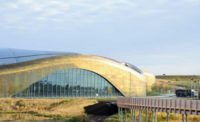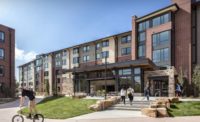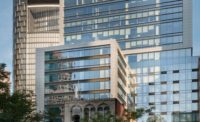Campus Enhanced by LEED Building with Copper Cladding

At the University of Massachusetts Amherst, a new Design Building has brought together previously dispersed departments in a LEED Gold structure that is integrated with the campus’ material palette. Leers Weinzapfel Associates, Boston, selected materials that speak to Amherst’s rural environment, particularly timber and metal. The team chose Dri-Design Wall Panels in a copper anodized finish to create a truly unique look.
According to the firm, the copper anodized aluminum panels laid out with vertical windows generate a colorful pattern like Amherst forests. The exterior also has the same palette as the area’s tobacco barns. Jeffrey Fishbein, AIA, associate at Leers Weinzapfel Associates, notes: “The owner valued a low-maintenance, economical and high-performance cladding system. The Dri-Design aluminum rainscreen system functions as a key component of the high-performance building envelope. The durable material maintains low life-cycle costs and requires no sealants. In addition, the copper-anodized finish works well as a modern material in a traditional brick campus context.”
R & R Window Contractors Inc., Easthampton, Mass., installed 26,294 square feet of 0.080-inch aluminum Copper Anodized panels. This finish allows designers to capture the warm glow of natural copper with the long-lasting durability of an anodized finish. The Copper Anodized finish has subtle variations of the copper-penny color from panel to panel that add depth and character to buildings. Like all Dri-Design panels, there are no sealants, gaskets or butyl tape in the panel joints. This means there are no dirty streaks or maintenance associated with the panels.
This was R&R Window Contractors first experience with Dri-Design. “We have worked with other metal wall panels but not with Dri-Design,” says Dave LaFosse, senior estimating manager with the company. He adds that the installation was made easier because of the panels’ precise sizes.
For the Design Building, Leers Weinzapfel Associates created a light-filled common center for students and faculty to collaborate that is surrounded by a coiling and rising band of studios, offices and classrooms. Above the commons is a roof terrace and garden, which doubles as a gathering area and teaching space for the landscape architecture department. The four-story structure is shared by the Building and Construction Technology program, Department of Architecture, and Department of Landscape Architecture and Regional Planning.
As a LEED Gold structure, there are many sustainable features, including: energy-efficient mechanical equipment with a heat recovery system, radiant heat flooring, chilled beams, natural daylighting, roof gardens, low-flow faucets, a stormwater management system for roof runoff, LED lighting, motion sensors, electro-tinting glass and more. The metal wall panels contribute to the LEED rating with their recycled content and recyclability.
“Design teams often turn to metal for green certified projects because of metal’s natural sustainable characteristics,” says Brad Zeeff, president of Dri-Design. “At Dri-Design, we enhance the sustainable appeal of metal by practicing efficient manufacturing with locally sourced materials. We create panels that are not made of composite materials and don’t use silicone sealants, saving petroleum and fossil fuels, as well as reducing waste. Our Kynar paint providers use a 100 percent air capture system to destroy VOCs in the finishing process. All of this—and more—are part of the fundamental practices at Dri-Design.”
For more information about the Dri-Design Wall Panel System, visit www.dri-design.com.
Looking for a reprint of this article?
From high-res PDFs to custom plaques, order your copy today!





